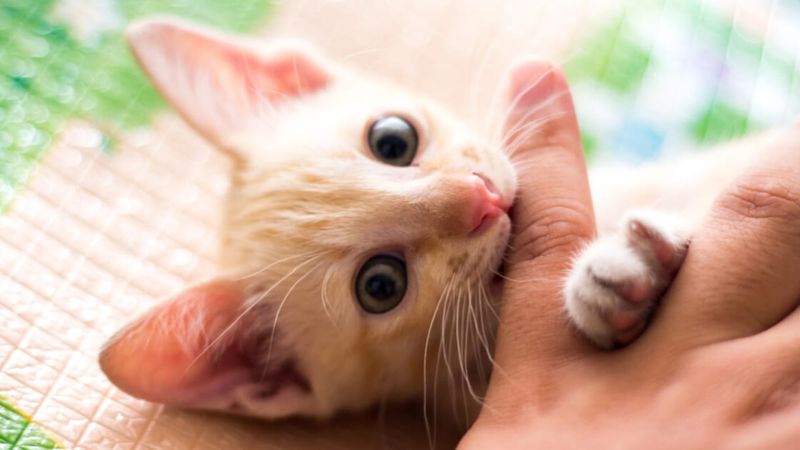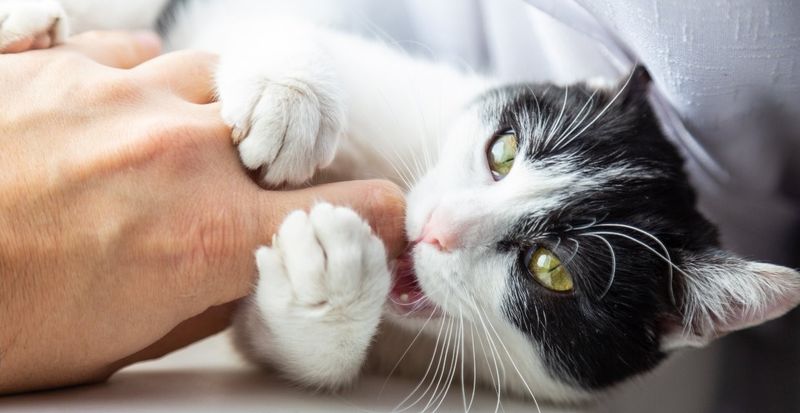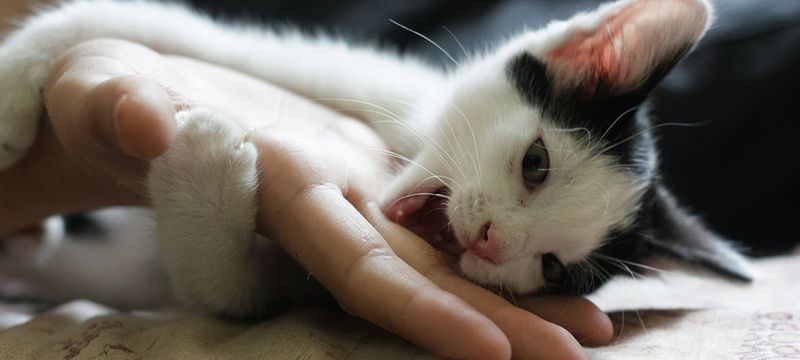📖 Table of Content:
Kitten bites can catch anyone off guard, turning a peaceful moment into a quick sting. Their sharp little teeth are built for exploring the world, but that doesn’t make the nips any less surprising. What seems like play often has a deeper purpose behind it.
Biting is a natural part of kitten development and communication. It can signal anything from teething discomfort to overstimulation or a desire to interact. Not all bites are meant aggressively—many are simply a way for kittens to learn boundaries.
Recognizing the reasons behind biting helps prevent it from becoming a habit. Paying attention to context and body language can make it easier to respond calmly and redirect the behavior. With time and guidance, most kittens grow out of the urge to bite during play.
1. Teething Troubles
Just like human babies, kittens go through a teething phase that can be uncomfortable and even painful. When those tiny teeth are pushing through sensitive gums, your kitten may bite to relieve the pressure and discomfort.
Providing appropriate chew toys can make a world of difference during this developmental stage. Look for soft rubber toys specifically designed for teething kittens. Cold toys can also provide extra relief – try keeping a few in the refrigerator.
Most kittens complete their teething process by six months of age, so this biting behavior should naturally decrease as they mature.
2. Overstimulation Response
Your kitten might be enjoying those pets and cuddles until suddenly – chomp! This seemingly random attack often happens because your furry friend has become overstimulated. Kittens have sensitive nervous systems that can quickly become overwhelmed by continued touching.
Watch for warning signs like tail twitching, skin rippling along the back, or dilated pupils. These signals indicate your kitten is reaching their stimulation threshold. When you notice these cues, it’s best to pause the petting session before teeth make an appearance.
Learning your individual kitten’s tolerance levels takes time, but creates a stronger bond between you both.
3. Fear-Based Defensive Biting
Contrary to their confident struts, kittens are actually quite vulnerable creatures. When frightened by loud noises, sudden movements, or unfamiliar situations, they may resort to biting as a defensive mechanism.
Creating a safe environment helps reduce fear-based biting. Offer plenty of hiding spots and quiet retreats throughout your home. Approach your kitten calmly and allow them to initiate interaction whenever possible.
Never punish a scared kitten for biting – this only confirms their fear. Instead, work on building trust through gentle handling and positive associations with people and new experiences.
4. Communication Method
Kittens use their mouths to explore and communicate with the world around them. A gentle nip might simply be your furball’s way of saying, “pay attention to me” or “I want to play now!”
Observing the context around biting helps decode these fuzzy messages. Does your kitten bite when you’re busy working? When the food bowl is empty? Or perhaps when you’ve been ignoring their attempts to initiate playtime?
Responding consistently to these communication attempts teaches your kitten better ways to express their needs. Redirecting to toys rather than fingers helps establish healthy boundaries.
5. Improper Weaning
Early separation from their mother can leave kittens without valuable guidance. Through play, both mom and siblings help teach how to bite gently and when to stop. Without this, young cats may struggle with rough play later on.
Orphaned or early-weaned kittens might not understand that their playful bites hurt humans. Their natural play involves wrestling and mock fighting with siblings, where they learn appropriate boundaries through feedback.
You can mimic this teaching by making a high-pitched “ouch” sound when your kitten bites too hard, then briefly stopping play. This consistent feedback helps your kitten develop the bite inhibition they missed in early kittenhood.
6. Health Issues or Pain
Sudden aggressive biting in normally gentle kittens often signals hidden health problems. Dental issues, injuries, or internal discomfort can cause your kitten to lash out when touched in sensitive areas.
Pay attention to patterns in the biting behavior. Does your kitten bite only when you touch certain body parts? Are they showing other unusual behaviors like changes in appetite, litter box habits, or activity levels?
A veterinary check-up is essential if you suspect pain-related biting. Early intervention for health issues not only stops the biting but also prevents your kitten from suffering in silence with conditions you can’t see.
7. Hunting Instinct Practice
Those adorable pounces and ankle attacks serve an evolutionary purpose. Your kitten’s brain is hardwired for hunting, and practicing these skills is crucial for their development – even for indoor cats who will never need to catch dinner.
Moving hands, feet, or even hair can trigger this predatory response. The quick movements resemble scurrying prey, activating your kitten’s natural hunting sequence: stalk, pounce, grab, and bite.
Structured play sessions with appropriate toys satisfy these instincts without turning your limbs into prey. Wand toys, small stuffed animals, or rolling balls give your kitten outlets for these important behaviors.







